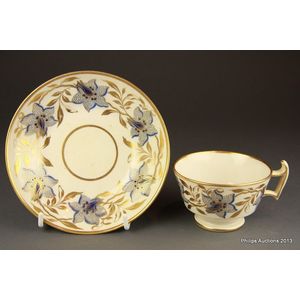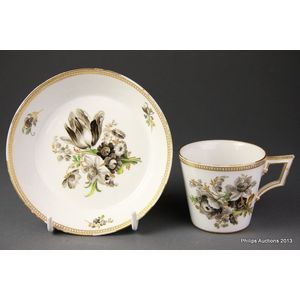Royal Vienna Cup and Saucer with Bucolic Scenes
You must be a subscriber, and be logged in to view price and dealer details.
Subscribe Now to view actual auction price for this item
When you subscribe, you have the option of setting the currency in which to display prices to $Au, $US, $NZ or Stg.
- Transfer Printed / Decorated Transferware - Transfer printing is method of decorating ceramics, reducing the cost of decoration when compared to employing artists to paint each piece. A print was taken on transfer-paper from an engraved copperplate, covered in ink prepared with metallic oxides, and the image on the paper was then applied to the biscuit-fired ceramic body. The print was fixed by heating the object in an oven, and then glazed, sealing the picture. Early transfer prints were blue and white, as cobalt was the only colour to stand firing without blurring. Early in the 19th century advances in the composition of the transfer paper resulted in better definition and detail, and enabled engravers to combine line-engraving with stipple.
- Ackermann, Rudolph - Rudolph Ackermann (1764 - 1834) was born in Saxony and is best known as a publisher of decorative coloured prints in London.
His early career demonstrated an entrepreneurial bent that was to lead to his success as a businessman in London.
At the age of 15 he was apprenticed to a saddler, and three years later moved to Dresden to train as a (horse-driven) carriage designer.
He later lived in Switzerland, France and Belgium for short periods, before moving to London in 1787.
He set up a successful business as a coach designer and decorator and in 1795 diversified his interest to include publishing and bookselling. His first decorative hand-coloured prints appeared in 1797. His output included political and social caricatures by leading artists of the day.
From 1809-1829 he published "Ackermann's Repository of Arts", an illustrated annual British periodical which covered arts, literature, commerce, manufactures, fashions, and politics, and had great influence on English taste in fashion, architecture, and literature.
His most ambitious venture was "The Microcosm of London". Which was completed in 1810 in collaboration with leading artists of the day, and contained 104 large folio hand-coloured aquatints.
In the following years he published further volumes, again working with artists such as William Pyne, established branches of his business in several Central and South American cities, and set up a publishing business for his son, also called Rudolph, one of his nine children in Regent Street, London. This business was taken over by Rudolph Junior's son Arthur, and was later renamed Arthur Ackermann Ltd. and was trading as fine art dealers until 2011.
His death in 1834 was preceded by a stroke in 1833 which left him partly paralysed.
This item has been included into following indexes:
Visually similar items

A Ridgway coffee cup and saucer, circa 1815, decoration pattern 419, the exterior of the London-shape cup and the border of the saucer with under-glaze blue and over-glaze gilt decoration of flowers and foliage on the cream-glazed ground, red-painted decor

A Miles Mason cup and saucer, circa 1805, the cup in Hamilton flute shape with the characteristic ring handle, both decorated with apricot borders and gilt vegetal motifs between gold bands, a gilt spray to the centre of the saucer; unmarked, height 6.5 cm

An early Meissen cup and saucer, circa 1790, a tapered cup and conforming straight sided saucer decorated with flower sprigs and grisaille bouquets of flowers, tulips, daffodils and others with touches of green and gilt highlights, an interlacing gold ribb

A Sevres first Empire coffee can and saucer, circa 1804-9 period. The straight-sided can with an ear form handle with continuous floral and sprigged borders in gilt and cobalt blue, the saucer conforming, with an iron red mark of the period underside to ca
